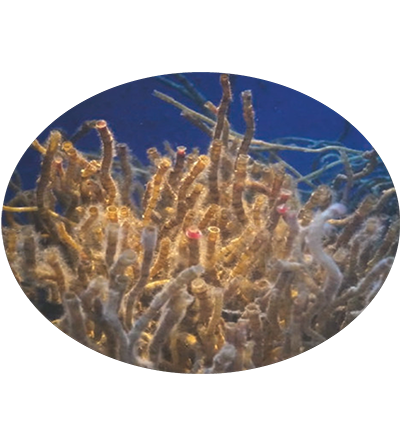
Lamellibrachia satsuma , also known as Satsuma tubeworm, is a vestimentiferan tube worm that was discovered near a hydrothermal vent in Kagoshima Bay, Kagoshima at the depth of only 82 m the shallowest depth record for a vestimentiferan. Its symbiotic sulfur oxidizer bacteria have been characterised as ε-Proteobacteria and γ-Proteobacteria. Subspecies have been later found associated with cold seeps at Hatsushima in Sagami Bay and at the Daini Tenryu Knoll in the Nankai Trough with specimens obtained at up to 1,170 m depth.
Animalia (Kingdom); Annelida (Phylum); Polychaeta (Class); Sedentaria (Subclass); Canalipalpata (Infraclass); Sabellida (Order); Siboglinidae (Family); Lamellibrachia (Genus); Lamellibrachia satsuma (Species)
Lamellibrachia satsuma Miura, 1997
1. Miura T. Lamellibrachia satsuma, a new species of vestimentiferan worms (Annelida: Pogonophora) from a shallow hydrothermal vent in Kagoshima Bay, Japan[J]. Proceedings of the Biological Society of Washington, 1997, 110: 447-456. (Miura et al., 1997)
The species has been later found associated with cold seeps at Hatsushima in Sagami Bay and at the Daini Tenryu Knoll in the Nankai Trough with specimens obtained at up to 1,170 m (3,840 ft) depth.
| Species | Phylum | Common Name | Ecosystem | Depth | Habitat | NCBI Taxonomy ID |
|---|---|---|---|---|---|---|
| Lamellibrachia satsuma | Annelida | tube worms | Cold seep | 110 | Kagoshima Bay, Kagoshima, Japan (31_39.756ʹN, 130_48.050ʹE) | 104711 |
| Genome Assembly | Genome Size | Assembly level | Released year | WGS accession | Submitter | BioProject | BUSCO completeness (%) | Scaffold/Contig N50 (kb) | GC content (%) | Repeat Rate (%) | Gene Number |
|---|---|---|---|---|---|---|---|---|---|---|---|
| ASM3323900v1 | 736Mb | Scaffold | 2023 | BSQZ01 | Atmosphere and Ocean Research Institute, The University of Tokyo | PRJDB14199 | 95.50 | 8,074/6,600 | 40.2 | - | 27,979 |
| Title | Journal | Pubmed ID |
|---|---|---|
| Genomic and transcriptomic analyses illuminate the molecular basis of the unique lifestyle of a tubeworm, Lamellibrachia satsuma | DNA Research | 37358253 |
| Gene ID | Description |
|---|---|
| Lsat_s106.g0048.t1 | SERINE/THREONINE-PROTEIN KINASE |
| Lsat_s106.g0049.t1 | SUPERKILLER 3 PROTEIN-RELATED |
| Lsat_s106.g0050.t1 | HELIX LOOP HELIX PROTEIN 21-RELATED |
| Lsat_s106.g0051.t1 | JTB PROTEIN-RELATED |
| Lsat_s106.g0052.t1 | CYTOCHROME C OXIDASE POLYPEPTIDE |
| Lsat_s106.g0053.t1 | BTB/POZ DOMAIN-CONTAINING |
| Lsat_s106.g0054.t1 | POLY ADP-RIBOSE POLYMERASE FAMILY, MEMBER PARP |
| Lsat_s106.g0055.t1 | GLUCOSE REPRESSIBLE PROTEIN MAK10 |
| Lsat_s106.g0056.t1 | SNURPORTIN1 RNUT1 PROTEIN RNA, U TRANSPORTER 1 |
| Lsat_s106.g0057.t1 | - |
| Lsat_s106.g0058.t1 | - |
| Lsat_s106.g0059.t1 | MULTIPLE PDZ DOMAIN PROTEIN |
| Lsat_s106.g0060.t1 | SER/THR-PROTEIN KINASE RIO2 |
| Lsat_s106.g0061.t1 | - |
| Lsat_s106.g0062.t1 | - |
| Lsat_s106.g0063.t1 | LYSM AND PUTATIVE PEPTIDOGLYCAN-BINDING DOMAIN-CONTAINING PROTEIN |
| Lsat_s106.g0064.t1 | CILIA- AND FLAGELLA-ASSOCIATED PROTEIN 161 |
| Lsat_s106.g0065.t1 | TRANS-GOLGI PROTEIN GMX33 |
| Lsat_s106.g0066.t1 | ANOCTAMIN |
| Lsat_s106.g0067.t1 | ANOCTAMIN |

